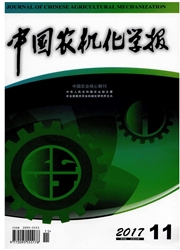

 中文摘要:
中文摘要:
以江西省万安县-脐橙果园土壤为研究对象,对采集到的57个土壤样本经风干、过筛,然后进行有机质含量测定,同时使用布鲁克TENSOR37型傅里叶变换近红外光谱仪进行光谱采集。采集到的光谱数据经过平滑(S--G)、标准正态变量变换(SNV)、一阶微分(1stD)、多元散射校正(Msc)4种方法预处理。然后通过遗传算法(GA)、连续投影算法(SPA)、正自适应加权算法(CARS)3种方法筛选出有机质的敏感波段。结果表明,正自适应加权算法(cARS)加权筛选出40个变量,其预测相关系数(Rp)为0.937,预测均方根误差(RMSEP)为0.410。这表明正自适应加权算法(CARs)可以有效的筛选出脐橙果园土壤有机质的敏感波段,同时为脐橙果园土壤有机质便携式仪器和传感器的开发提供参考。
 英文摘要:
英文摘要:
To study the distribution of soil nutrients and build soil models of soil organic matter (SOM) that could predict the meas- ured value, the soil samples coming from Wanan County, Jiangxi Province navel orange orchard were collected. The precision of the soil organic matter measurement using near-infrared spectra and quantitative analysis model method on the sample condition, soil sam- ples were air-dried and sieved through 0. 149 mm screen holes after grinding. The collected spectral data retreated by Savizky-Golay smoothing, standard normalized variate, multiplicative scatter correction and first derivative, and find out use the original data was the best, then used genetic algorithm (GA), successive projections algorithm (SPA) and competitive adaptive reweighted sampling (CARS) to selection variables. And found that the variables selection by CARS gives the best results with and the correlation coefficient (Rp) of 0.9,37 the root mean square error of prediction (RMSEP) of 0. 410. The research shows that the variable selection methods by CARS could predict the organic matter content in the soil of Gannan navel orange orchard, meanwhile provide a reference for the development of navel orange orchard soil organic matter portable instruments and sensors.
 同期刊论文项目
同期刊论文项目
 同项目期刊论文
同项目期刊论文
 determination of copper and zinc pollutants in Ludwigia prost rate Roxb using near infrared reflecta
determination of copper and zinc pollutants in Ludwigia prost rate Roxb using near infrared reflecta 期刊信息
期刊信息
